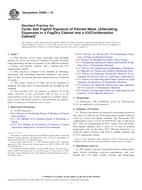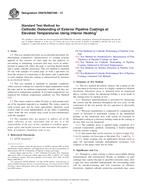Potrebujeme váš súhlas na využitie jednotlivých dát, aby sa vám okrem iného mohli ukazovať informácie týkajúce sa vašich záujmov. Súhlas udelíte kliknutím na tlačidlo „OK“.
ASTM D5894-10
Standard Practice for Cyclic Salt Fog/UV Exposure of Painted Metal, (Alternating Exposures in a Fog/Dry Cabinet and a UV/Condensation Cabinet)
Automaticky preložený názov:
Štandardné praktiky pre cyklický Salt Fog / UV žiarenia z lakovaného kovu, (striedavý expozícií v hmle / Dry kabinetu a UV / kondenzácia skrinka)
NORMA vydaná dňa 1.12.2010
Informácie o norme:
Označenie normy: ASTM D5894-10
Poznámka: NEPLATNÁ
Dátum vydania normy: 1.12.2010
Kód tovaru: NS-32981
Počet strán: 4
Približná hmotnosť: 12 g (0.03 libier)
Krajina: Americká technická norma
Kategória: Technické normy ASTM
Kategórie - podobné normy:
Anotácia textu normy ASTM D5894-10 :
Keywords:
accelerated aging/testingpaints, corrosion, cyclic corrosion, rust, salt spray, ultraviolet, Accelerated aging/testing--paints/related coatings, Corrosion--paints/related coatings/materials, Cyclic corrosion testing, Rust, Salt spray (fog) testing, Ultraviolet (UV) analysis, UV/condensation cabinet, ICS Number Code 87.040 (Paints and varnishes)
Doplňujúce informácie
| Significance and Use | ||||||||||||||||||
|
The outdoor corrosion of painted metals is influenced by many factors, including: corrosive atmospheres, rain, condensed dew, UV light, wet/dry cycling, and temperature cycling. These factors frequently have a synergistic effect on one another. This practice is intended to provide a more realistic simulation of the interaction of these factors than is found in traditional tests with continuous exposure to a static set of corrosive conditions. Results obtained from this practice can be used to compare the relative durability of materials subjected to the specific test cycle used. No single exposure test can be specified as a complete simulation of actual use conditions in outdoor environments. Results obtained from exposures conducted according to this practice can be considered as representative of actual outdoor exposures only when the degree of rank correlation has been established for the specific materials being tested. The relative durability of materials in actual outdoor service can be very different in different locations because of differences in UV radiation, time of wetness, temperature, pollutants, and other factors. Therefore, even if results from a specific artificial test condition are found to be useful for comparing the relative durability of materials exposed in a particular exterior environment, it cannot be assumed that they will be useful for determining relative durability for a different environment. Even though it is very tempting, it is not recommended to calculate an “acceleration factor” relating xhours of laboratory exposure to y months of exterior exposure. Different materials and different formulations of the same material can have significantly different acceleration factors. The acceleration factor also varies depending on the variability in rate of degradation in the laboratory test and in actual outdoor exposure. This practice is best used to compare the relative performance of materials tested at the same time in the same exposure device. Because of possible variability between the same type of exposure devices, it is not recommended to compare the amount of degradation in materials exposed for the same duration at separate times, or in separate devices running the same test condition. This practice should not be used to establish a “pass/fail” approval of materials after a specific period of exposure unless performance comparisons are made relative to a control material exposed simultaneously, or the variability in the test is rigorously quantified so that statistically significant pass/fail judgments can be made. This practice has been found useful for air-dry industrial maintenance paints on steel , , , , and zinc-rich primers but its applicability has not yet been assessed for galvanized substrates. |
||||||||||||||||||
| 1. Scope | ||||||||||||||||||
|
1.1 This practice covers basic principles and operating practice for cyclic corrosion/UV exposure of paints on metal, using alternating periods of exposure in two different cabinets: a cycling salt fog/dry cabinet, and a fluorescent UV/condensation cabinet. 1.2 This practice is limited to the methods of obtaining, measuring, and controlling exposure conditions, and procedures. It does not specify specimen preparation nor evaluation of results. 1.3 The values stated in SI units are to be regarded as standard. No other units of measurement are included in this standard. 1.4 This standard does not purport to address all of the safety concerns, if any, associated with its use. It is the responsibility of the user of this standard to establish appropriate safety and health practices and determine the applicability of regulatory limitations prior to use. |
||||||||||||||||||
| 2. Referenced Documents | ||||||||||||||||||
|
Podobné normy:
Historická
1.6.2011
Historická
1.11.2013
Historická
1.11.2012
Historická
1.2.2013
Historická
1.2.2011
Historická
15.2.2011
Odporúčame:
Aktualizácia technických noriem
Chcete mať istotu, že používate len platné technické normy?
Ponúkame Vám riešenie, ktoré Vám zaistí mesačný prehľad o aktuálnosti noriem, ktoré používate.
Chcete vedieť viac informácií ? Pozrite sa na túto stránku.



 ASTM D6093-97(2011)..
ASTM D6093-97(2011).. ASTM D6676/D6676M-13..
ASTM D6676/D6676M-13.. ASTM D6677-07(2012)..
ASTM D6677-07(2012).. ASTM D6686-01(2013)..
ASTM D6686-01(2013).. ASTM D7541-11
ASTM D7541-11 ASTM E2338-11
ASTM E2338-11
 Cookies
Cookies
